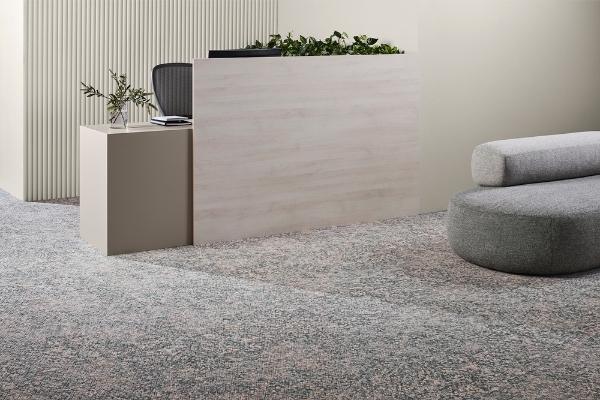
Material design choices in today’s buildings have a deeper impact that goes beyond their form and function. Specified building materials can affect the indoor environment and human health, the greater ecosystem, supply chain and beyond. Product transparency is key, and manufacturers that are open about their products enable choices that can transform our industry for the better.
Product ingredients, indicators for environmental impact, toxicity and sustainable building benchmarks, should be considered as a set of performance attributes. This is why labels like Declare that allow manufacturers to voluntarily disclose product information are important.
Declare labels help specifiers quickly identify products that meet their project’s sustainability and healthy material requirements. Declare labels display all intentionally-added ingredients and residuals at or above 100ppm (0.01%) present in the final product by weight. Each ingredient must be reported with a chemical name, CAS number, and percentage or percentage range.
These product constituents are presented on a label, akin to a nutritional label, along with end-of-life information, responsible sourcing, VOC content, emissions testing, LBC compliance and other information designed to help specifiers better understand each product.
By facilitating and simplifying the exchange of complex ingredient information, Declare has positively changed the materials marketplace to enable buildings that support human and environmental health and an industry with increased material health awareness.
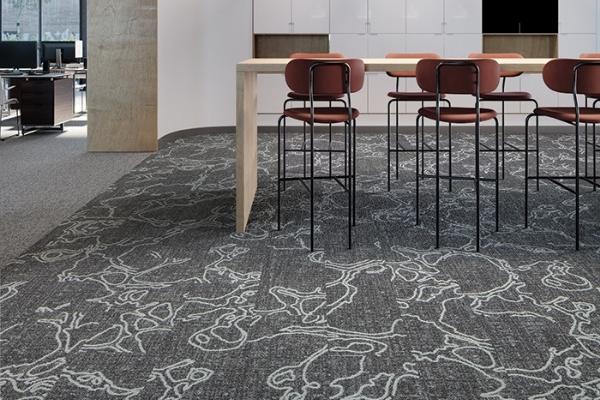
Transformation through transparency is something that resonates with Australian flooring manufacturers. GH Commercial currently have 18 products on Declare, all of them LBC Red List Free, setting an incredibly high industry benchmark.
“Naturally we were drawn to the idea of product transparency highlighting that we can make better products here and not just letting the industry rely on imported solutions from around the world,” says Joel Williamson, National Sales Manager at GH Commercial.
“As a large company, getting all the stakeholders throughout the business to agree that we won’t use materials on the Red List is important because it forces our teams to ask questions and be responsible for what they do,” says Joel.
GH Commercial’s early adoption of the Declare program was spurred by a shift in industry towards holistic sustainability initiatives that addressed multiple environmental issues. A move towards materials that tackled waste, toxicity and climate rather than ticking only one box became the clear next step for GH Commercial.
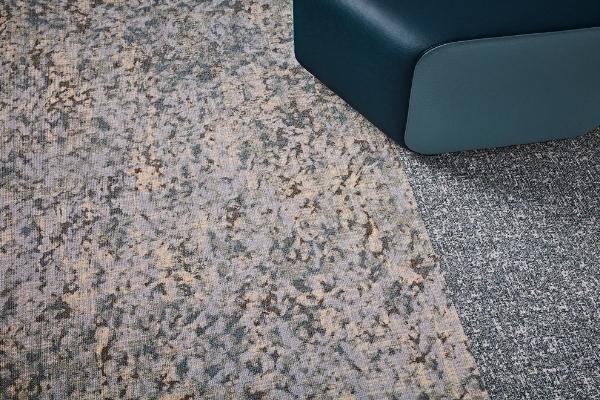
“We decided to pursue Declare certification early in our journey towards becoming a fully sustainable manufacturing facility because we feel it is a fundamental benchmark that helps to define our process,” says Joel.
GH Commercial’s mission statement is to ‘Believe in Better’ and knowing better is a crucial step in the pathway to doing that. “We are continuously challenging ourselves to create better interior spaces and better work environments by using safe and healthy materials in our products. Our focus on material health is a never-ending journey,” says GH Commercial Corporate Sales & Sustainability Coordinator, Lachlan Howell.
“We actively list, screen, assess and optimise our list of ingredients across our product portfolio as we move forward to bring innovative and sustainable flooring solutions to market,” he says.
The auxiliary effect of materials transparency for GH Commercial is a shift in thinking internally and externally. Joel describes a ‘significant’ shift in customer thinking as demand for transparency grows. “It’s no longer okay to hide behind complexity. Customers want to know where things are made and what is in them,” says Joel.
Programs like Declare provide a framework that can be used to meet customer expectations and help the GH Commercial team make better sourcing choices. “As Australia’s largest carpet manufacturer and supplier of resilient flooring, we understand the role we can play in generating systematic change and transforming the built environment. Our commitment to material health and product circularity are key pillars that drive our organisation in bringing new innovative and sustainable flooring solutions to market,” says Lachlan.
Better still, a commitment to holistic healthy materials creates a valued work culture. “If you walk through our facilities, you will see hundreds of people who are proud of what they do and what they produce. A Declare label is the trophy for all the care and hard work that goes into making our products every day and we are proud to share this with our customers,” says Joel.
A Closer look at on of the GH Commercial Declare Labels
The Optic Reset Collection is one of GH Commercial’s newest carpet tile product ranges.
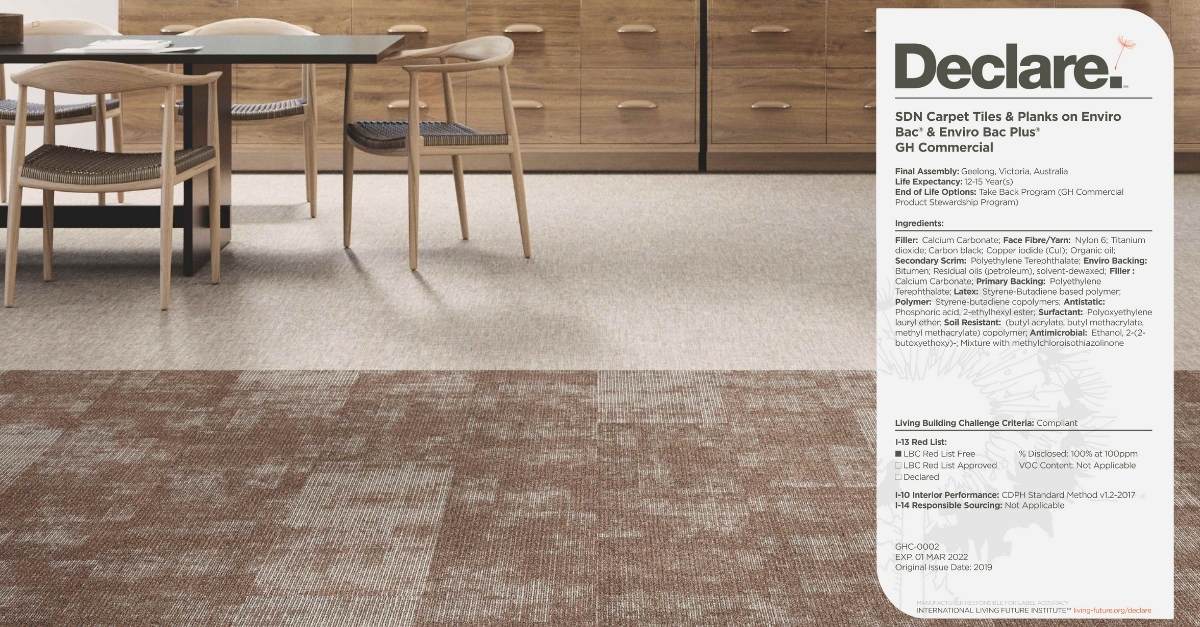
PRODUCT: The Optic Reset Collection
END OF LIFE OPTIONS:
Through the GHC Loop Program, carpet tiles are collected, graded and reused for their original purpose in a new installation that ranges from charities, schools, price-conscious buyers to environmentally-conscious corporate clients. This program truly closes the loop, without destroying value and requiring minimal energy needs.
For worn-down carpet tiles and flooring types other than carpet tiles, the 3R Program applies. The 3R program stands for Reclaim, Recycle and Reprocess. All GH Commercial broadloom carpets, modular carpets and vinyl flooring products (including Godfrey Hirst, Feltex, IVC Commercial and Mohawk Group products) can be returned at the end of their first life to feed a number of small, innovative projects.
INGREDIENTS: All of the ingredients that are used to make up this product are listed, down to 100 parts per million, or 0.01%.
RED LIST FREE:
The LBC Red List contains the ‘worst in class’ materials, chemicals and elements known to pose serious risks to human health and the greater ecosystem that are prevalent in the building products industry.
Obtaining the level of detail required to apply for Red List Free status requires that the manufacturer compile information on every ingredient of their product – a process that relies highly on a transparent supply chain. This means reaching out to suppliers for information, sourcing relevant certificates such as emissions testing and ensuring that no Red List materials are included. In some cases, suppliers might need to change or in a more favourable situation, the supplier may agree to improve their transparency or the health of their ‘ingredient’.
It’s an extensive process that manufacturers have to commit to annually as the Red List is continually updated. The more CAS numbers of component ingredients, the more there is to be checked with the supply chain.
Declare Label products can have one of three Declaration Statuses:
- LBC RED LIST FREE products disclose 100% of ingredients present at or above 100 ppm (0.01%) in the final product and do not contain any Red List chemicals.
- LBC RED LIST APPROVED products disclose a minimum of 99% of ingredients present in the final product and meet the LBC Red List Imperative requirements through one or more approved exceptions.
- DECLARED products disclose 100% of ingredients present in the final product, but contain one or more Red List chemicals that are not covered by an approved exception.
In Australia, there are only 37 products with Red List Free status.
A long-time example of worst-in-class is polyvinyl chloride (PVC). This type of plastic has many material uses but is widely used in commercial flooring at a non-slip or waterproofing backing for carpet. PVC is on the Red List as a source material for Persistent Organic Pollutants (POP).
Persistent Organic Pollutants are a class of chemicals that aren’t easily broken down and remain in the environment (in water bodies, soil or air) for long periods of time. These toxic chemicals can accumulate in the environment and in the food chain where they can have a toxic effect on organisms. A well-known example of a POP is the herbicide DDT.
Due to its chlorine content, PVC often contains other Red List ingredients, such as cadmium, lead, and phthalates. The manufacture and disposal of chlorinated polymers can result in the production of dioxins and disposal phases. Dioxins are some of the most potent toxins known to humans, with no known safe limit for exposure and a strong propensity for bioaccumulation. In addition, dioxins are highly persistent in the environment.
The Optic Reset Collection is one of GH Commercial’s newest carpet tile product ranges that is LBC Red List Free, and made with PVC free Enviro Bac®.

